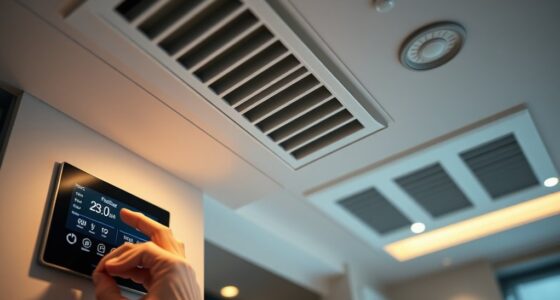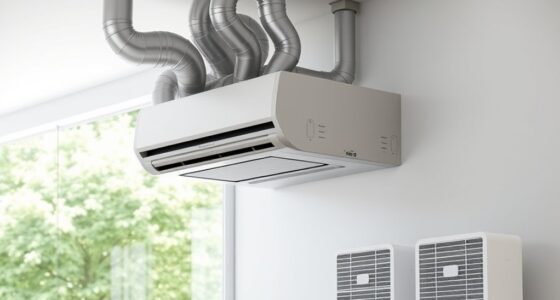Green HVAC design combines energy efficiency with indoor air quality to create healthier, more sustainable buildings. By using renewable energy sources, sustainable materials, and advanced system controls, you can lower energy costs and reduce environmental impact. Eco-friendly materials emit fewer pollutants, improving IAQ for occupants. Incorporating smart technology and renewable energy ensures ideal performance and resilience. Continue exploring these strategies to discover how they can transform your building’s efficiency and health.
Key Takeaways
- Incorporate renewable energy sources like solar and wind to power HVAC systems, reducing reliance on fossil fuels and lowering emissions.
- Use sustainable, low-VOC materials to improve indoor air quality while minimizing environmental impact throughout the system’s lifecycle.
- Integrate advanced technologies such as heat recovery ventilators and smart controls to enhance energy efficiency and optimize IAQ.
- Design systems that balance proper ventilation with energy conservation, ensuring healthy indoor environments and efficient airflow management.
- Prioritize long-term economic benefits through reduced operating costs, lower maintenance, and increased building resilience aligned with sustainability goals.

Green HVAC design focuses on creating heating, ventilation, and air conditioning systems that are energy-efficient and environmentally friendly. When you prioritize renewable energy sources, you’re reducing dependence on fossil fuels, which cuts down greenhouse gas emissions and lowers your carbon footprint. Solar panels, wind turbines, and geothermal systems are common renewable options integrated into green HVAC solutions. By harnessing these sustainable energy sources, you can power your HVAC system more cleanly and reliably, making your building not only eco-friendly but also more resilient to energy price fluctuations. Additionally, using sustainable materials in your HVAC system’s construction and maintenance further minimizes environmental impact. These materials are designed to be biodegradable, recyclable, or derived from renewable resources, ensuring that your system’s lifecycle has a reduced ecological footprint. For example, incorporating recycled metal components or bio-based insulation materials helps you align your HVAC design with sustainability goals. Incorporating renewable energy sources into your HVAC system enhances overall efficiency and sustainability. You’ll find that selecting sustainable materials can also improve indoor air quality (IAQ), as many eco-friendly options emit fewer volatile organic compounds (VOCs) and other harmful pollutants. This means you’re creating a healthier environment for occupants, which is especially important in commercial or residential spaces where people spend a lot of time. Green HVAC design emphasizes not just energy efficiency but also the importance of IAQ, ensuring fresh air circulates properly while minimizing energy waste. Incorporating advanced filtration systems and smart ventilation controls allows you to optimize airflow and maintain a balanced indoor environment. Moreover, integrating renewable energy and sustainable materials often involves employing innovative technology, such as heat recovery ventilators or energy-efficient heat pumps. These systems make use of existing energy more effectively, reducing overall consumption without sacrificing comfort. When you choose energy-efficient equipment and sustainable materials, you’re also likely to benefit from lower operating costs over time. Reduced energy bills, maintenance costs, and longer equipment lifespan make these investments financially sensible as well as environmentally responsible. In essence, green HVAC design is about more than just reducing energy use; it’s about creating a holistic approach that combines renewable energy, sustainable materials, and IAQ considerations. By doing so, you contribute to a healthier planet while providing a comfortable, safe indoor environment. The integration of these elements demonstrates that sustainable HVAC solutions are not only feasible but essential for building operations moving forward.
Frequently Asked Questions
How Do Green HVAC Systems Impact Overall Building Sustainability?
Green HVAC systems boost your building’s sustainability by reducing energy consumption through renewable energy integration and enhancing water conservation. You’ll lower your carbon footprint while maintaining healthy indoor air quality. These systems optimize energy use, decrease reliance on non-renewable resources, and promote eco-friendly water practices. As a result, your building becomes more efficient, environmentally responsible, and cost-effective, supporting a sustainable future for both your space and the planet.
What Are the Initial Costs Versus Long-Term Savings of Green HVAC?
While the initial costs of green HVAC systems might seem a bit higher, you’re investing in long-term savings that often outweigh upfront expenses. The cost comparison shows that energy efficiency and improved IAQ lead to reduced utility bills and maintenance costs over time. Your smart investment results in a quicker-than-expected return, making it a financially sound choice that benefits both your budget and the environment.
How Can Green HVAC Systems Be Customized for Different Building Types?
You can customize green HVAC systems for different building types through building customization and system integration. For commercial spaces, prioritize advanced filtration and zoning controls to enhance IAQ. In residential buildings, focus on energy-efficient heat pumps and smart thermostats. Incorporate tailored ventilation and insulation strategies based on building size and use. By aligning system features with specific building needs, you optimize both energy efficiency and indoor air quality effectively.
What Are the Most Common Challenges in Implementing Green HVAC Designs?
You might face challenges like cost barriers and technical complexities when implementing green HVAC designs. The initial investment can be high, making it tough to justify, especially for budget-conscious projects. Additionally, integrating advanced technologies often requires specialized knowledge and skills, which can slow down the process. Overcoming these hurdles involves careful planning, seeking incentives, and working with experts to guarantee a seamless shift to sustainable solutions.
How Do Green HVAC Strategies Affect Indoor Comfort and Occupant Health?
Green HVAC strategies improve indoor comfort and occupant health by enhancing air quality and maintaining ideal thermal comfort. You’ll notice better ventilation, reduced pollutants, and consistent temperatures, creating a healthier environment. These systems use energy-efficient technologies to guarantee fresh air circulates effectively while minimizing drafts or hot spots. As a result, you experience increased productivity, fewer health issues, and a more comfortable, sustainable space that supports well-being.
Conclusion
By blending bold building practices with brilliant, breathable ventilation, you foster a future filled with fresher air and fuller efficiency. Green HVAC design isn’t just about going green; it’s about gaining greatness in energy savings and indoor air quality. Embrace eco-friendly innovations today, and you’ll create healthier habitats, happier homes, and a sustainable society. Make mindful moves now—your mastery in managing moisture, minimizing waste, and maximizing comfort will mold a better, brighter tomorrow.










